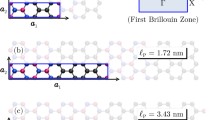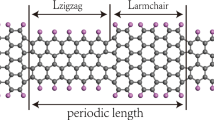Abstract
We report the effect of topological as well as lattice vacancy defects on the electro-thermal transport properties of the metallic zigzag graphene nano ribbons at their ballistic limit. We employ the density function theory–Non equilibrium green’s function combination to calculate the transmission details. We then present an elaborated study considering the variation in the electrical current and the heat current transport with the change in temperature as well as the voltage gradient across the nano ribbons. The comparative analysis shows, that in the case of topological defects, such as the Stone-Wales defect, the electrical current transport is minimum. Besides, for the voltage gradient of 0.5 Volt and the temperature gradient of 300 K, the heat current transport reduces by \({\sim }62\,\%\) and \({\sim }50\,\%\) for the cases of Stones-Wales defect and lattice vacancy defect respectively, compared to that of the perfect one.

















Similar content being viewed by others
References
Balandin, A.A.: The heat is on: graphene applications, thermal management of nanoelectronics and 3-D electronics. IEEE Nanotechnol. Mag. 5, 15–19 (2011)
Balandin, A.A.: Chill out: new materials and designs can keep chips cool. IEEE Spectr. 29, 29–33 (2009)
Novoselov, K., et al.: Electric field effect in atomically thin carbon films. Science 306, 666–669 (2004)
Novoselov, K., et al.: Two-dimensional gas of massless Dirac fermions in graphene. Nat. Lett. 438, 197–200 (2005)
Wong, HSPhilip, Akinwande, D.: Carbon Nanotube and Graphene Device Physics. Cambridge University Press, Cambridge (2011)
Srivastava, N., et al.: On the applicability of single-walled carbon nanotubes as VLSI interconnects. IEEE Trans. Nanotechnol. 8, 4 (2009)
Balandin, A.A., et al.: Superior thermal conductivity of single-layer graphene. Nano Lett. 8(3), 902–907 (2008)
Bolotin, K.I., Sikes, K.J., Hone, J., Stormer, H.L., Kim, P.: Temperature-dependent transport in suspended graphene. Phys. Rev. Lett. 101(9), 096802 (2008)
Radisavljevic, B., Radenovic, A., Brivio, J., Giacometti, V., Kis, A.: Single-layer MoS2 transistors. Nat. Nanotechnol. Lett. 6, 147–150 (2011)
Han, M., Ozyilmaz, B., Zhang, Y., Kim, P.: Energy band-gap engineering of graphene nanoribbons. Phys. Rev. Lett. 98(20), 206805-1–206805-4 (2007)
Zhang, A., et al.: Intrinsic and extrinsic performance limits of graphene devices on SiO2. Appl. Phys. Lett. 98(023105–1), 023105-1–023105-3 (2011)
Li, X., Wang, X., Zhang, L., Lee, S., Dai, H.: Chemically derived, ultrasmooth graphene nanoribbon semiconductors. Science 319, 1229–1231 (2008)
Xu, C., Li, H., Banerjee, K.: Modeling, analysis, and design of graphene nano-ribbon interconnects. IEEE Trans. Electron Devices 56, 8 (2009)
Khatami, Y., Kang, J., Banerjee, K.: Graphene nanoribbon based negative resistance device for ultra-low voltage digital logic applications. Appl. Phys. Lett. 102, 043114 (2013)
Sahin, H., Senger, R.T.: First pinciple calculations of spin dependent conductance of graphene flakes. Phys. Rev. B 78, 205423-1–205423-8 (2008)
Areshkin, D.A., et al.: Ballistic transport in graphene nanostrips in presence of disorder: importance of edge effects. ACS Nano Lett. 7(1), 204–210 (2007)
Son, Y.-W., Cohen, M.L., Louie, S.G.: Half-metallic graphene nanoribbons. Nat. Lett. 444, 347–349 (2006)
Yoon, Y., Guo, J.: Effects of edge roughness in graphene nanoribbon transistors. Appl. Phys Lett. 91, 073103 (2007)
Ren, Y., Chen, K.-Q.: Effects of symmetry and Stone-Wales defect on spin-dependent electronic transport in zigzag graphene nanoribbons. J. Appl. Phys. 107, 044514 (2010)
Yazdanpanah, A., et al.: A numerical study of line-edge roughness scattering in graphene nanoribbons. IEEE Trans. Electron Devices 59(2), 433–440 (2012)
Ouyan, Y., Guo, J.: A theoretical study on thermoelectric properties of graphene nanoribbons. Appl. Phys. Lett. 94, 263107 (2009)
Ni, X., et al.: Disorder enhances thermoelectric figure of merit in armchair graphene nano ribbons. Appl. Phys. Lett. 95, 192114 (2009)
Yokomizo, Y., Nakamura, J.: Giant Seebeck coefficient of the graphene/h-BN superlattices. Appl. Phys. Lett. 103, 113901 (2013)
Aksamija, Z., Knezevic, I.: Thermal transport in graphene nanoribbons supported on \(\text{ SiO }_{2}\). Phys. Rev. B 86, 165426 (2012)
Evans, W.J., Hu, L., Keblinski, P.: Thermal conductivity of graphene ribbons from equilibrium molecular dynamics: effects of ribbon width, edge roughness, and hydrogen termination. Appl. Phys. Lett. 96, 203112 (2010)
Karamitaheri, H., et al.: Atomistic study of the lattice thermal conductivity of rough graphene nanoribbons. IEEE Trans. Electron Devices 60, 7 (2013)
Sengupta, A., Mahapatra, S.: Negative differential resistance and effect of defects and deformation in MoS2 armchair nanoribbon metal-oxide-semiconductor field effect transistor. J. Appl. Phys. 114, 194513-1–194513-5 (2013)
Soler, J., et al.: The SIESTA method for ab initio order-N materials simulation. J. Phys.:Condens. Matt. 14, 2745–2779 (2002)
The ATK-DFT package. Atomistix ToolKit Reference Manual. http://www.quantumwise.com/
Monkhorst, H.J., Pack, J.D.: On special points for Brillouin zone integrations. Phys. Rev. B 13, 5188 (1976)
Ma, J., Alfe, D., Michaelides, A., Wang, E.: Stone-Wales defects in graphene and oher plannar sp2-bonded materials. Phys. Rev. B 80, 033407 (2009)
Zsoldos, I.: Effect of topological defects on graphene geometry and stability. Nanotechnol. Sci. Appl. 2010(3), 101–106 (2010)
Song, L.L., et al.: Dangling bond states, edge magnetism, and edge reconstruction in pristine and B/N-terminated zigzag graphene nanoribbons. J. Phys. Chem. C 114, 12145–12150 (2010)
Girit, C.O., et al.: Graphene at the edge: stability and dynamics. Science 323, 1705–1708 (2009)
Lundstrom M.: Thermoelectric effects—mathematics, near-equilibrium transport, fundamentals and applications. http://www.nanoHUB.org (2011)
Mazzamuto, F., et al.: Enhanced thermoelectric properties in graphene nanoribbons by resonant tunneling of electrons. Phys. Rev. B 83, 235426 (2011)
Landauer, R.: Spatial variation of currents and fields due to localized scatterers in metallic conduction. IBM J. 1, 223–231 (1957)
Buttiker, M., et al.: Generalized many-channel conductance formula with application to small rings. Phys. Rev. B 31, 6207–6215 (1985)
Fisher, D.S., Lee, P.A.: Relation between conductivity and transmission matrix. Phys. Rev. B 23, 6851–6854 (1981)
Esfarjani, K., Zebarjadi, M., Kawazoe, Y.: Thermoelectric properties of a nanocontact made of two-capped single-wall carbon nanotubes calculated within the tight-binding approximation. Phys. Rev. B 73, 085406 (2006)
Jiang, J.-W., Wang, J.-S., Li, B.: A nonequilibrium Greens function study of thermoelectric properties in single-walled carbon nanotubes. J. Appl. Phys. 109, 014326 (2011)
Kim, R., Datta, S., Lundstrom, M.S.: Influence of dimensionality on thermoelectric device performance. J. Appl. Phys. 105, 034506 (2009)
Verma, R., Bhattacharya, S., Mahapatra, S.: Solution of Time Dependent Joule Heat Equation for a Graphene Sheet under Thomson Effect. IEEE Trans. Electron Devices 60, 10 (2013)
Jeong, C.: On Landauer versus Boltzmann and full band versus effective mass evaluation of thermoelectric transport coefficients. J. Appl. Phys. 107, 023707 (2010)
Acknowledgments
Dr. A. Sengupta thanks DST, Govt. of India, for the DST Post-doctoral Fellowship in Nano Science and Technology.
Dr. S. Bhattacharya thanks DST, Govt. of India, for the Inspire-faculty grant, 2013.
Author information
Authors and Affiliations
Corresponding author
Rights and permissions
About this article
Cite this article
Saha, D., Sengupta, A., Bhattacharya, S. et al. Impact of Stone-Wales and lattice vacancy defects on the electro-thermal transport of the free standing structure of metallic ZGNR. J Comput Electron 13, 862–871 (2014). https://doi.org/10.1007/s10825-014-0601-0
Published:
Issue Date:
DOI: https://doi.org/10.1007/s10825-014-0601-0




